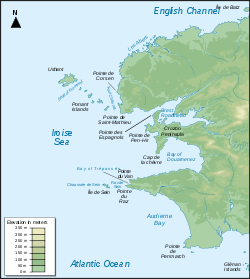Iroise Sea

Iroise or the Iroise Sea (French: mer d'Iroise, pronounced: [i.ʁwɑz] or [i.ʁwa])[1] is the part of the Atlantic Ocean which stretches from the Ile de Sein to Ushant off the coast of Brittany in north-western France. It borders the Celtic Sea to the north and west and the Bay of Biscay to the south. It is one of the most dangerous seas in Europe. In winter, there are often violent storms with huge waves. But it is also considered to be one of the richest areas for marine life leading to its inclusion as one of UNESCO's biosphere reserves in 1988 and as France's first marine park in October 2007.[2]
Name and extent
The name is first recorded in the Neptune francois of 1693 as Le Passage de l'Yroise (passage = "channel"); as Passage de l'Iroise in the 18th century; as Iroise in the 19th century; and as mer d'Iroise (mer = "sea") in the 1970s, by the seabed exploration industry.[3] The name appears to have been fixed not by local seafarers but rather by the naval base at Brest.[3] The 18th-century maps restrict "Passage de l'Iroise" to the channel leading north-west from Pointe Saint-Mathieu and keeping south of Ushant and the Ponant Islands.[3] From the 19th century, Iroise encompasses all the sea the west coast of Brittany, between Ouessant and Sein.[3] While this remains the limit used by mariners,[4] some twentieth-century sources have used mer d'Iroise to denote the entire Celtic Sea as far as Ireland and England.[3]
The meaning of Iroise is obscure; theories include:[5]
- from the Old French Iroise meaning "Irish", denoting the route from France to Ireland[4]
- from a dubious Old French adjective iroise meaning "angry", referring to the rough seas (sometimes Angry Sea is found as an English language translation)[6]
- from Breton hirgwaz; hir "long" + gwaz "stream, channel"[4]
- From the Breton ervoas "deep", referring to the Atlantic Ocean, in contrast to the shallow English Channel[7]
From the 1990s, "Iroise" became popular in Finistère in the name of many local businesses and associations.[4][8] The Pont de l'Iroise bridge was opened in 1994.
Location and environment
The Iroise coastline consists of a rich variety of beaches, rocky cliffs, sand dunes, coves and islands such as the Île de Sein and the Island of Molene.
The considerable differences in depth and the adjacent English Channel are responsible for the strong currents through the Iroise. High tides in the Channel bring about strong north-easterly currents which reverse at low tide. The currents can reach particularly high speeds at the Raz de Sein or the Goulet de Brest.
As a result, there are many lighthouses is the area and many local legends describing tragedies at sea.
Activities
The Iroise Sea enjoys a variety of activities. The French navy has been present there since 1631 when Brest became a naval base and, more recently, it has been a centre of submarine activity owing to the nuclear submarine base at Île Longue on the Crozon peninsula in the roadstead of Brest. Fishing, though less important than in the past, is still practiced especially through the ports of Le Conquet, Douarnenez, Camaret and Brest where catches range from crabs to sardines and monkfish. The area is also popular for sailing and pleasure boating, particularly in the less exposed areas along the coast and in the Douarnenez Bay. Diving is also increasingly popular, particularly in view of the many accessible wrecks and spectacular underwater vistas.

Sea search and rescue
Owing to the hazardous conditions at sea, the high density of shipping and a number of shipwrecks in recent years, the French authorities have introduced special search and rescue operations which include vessels such as the Abeille Bourbon as well as a number of large lifeboats in the ports of Douarnenez, Camaret, Le Conquet, Molène and Ushant.
Marine Park
Despite several major oil spills and cases of overfishing, the Iroise Sea is still rich in flora and fauna. It is especially well known for its seabass, its shoals of dolphin, seals, sea otters, lobsters and, on occasion, sunfish, basking shark and even whales. There are also many varieties of seabird including cormorants, guillemots and herons. The sea is also recognized as the richest environment for seaweed in Europe with some 300 species. As a result, on 2 October 2007, after years of debate and discussion, the French authorities created the country's very first marine park, officially labelled Parc naturel marin d'Iroise. The three main objectives are to increase knowledge of the marine environment, to protect the area's habitats and species and to develop marine activities of all kinds. The Iroise Marine Park covers an area of 3,550 km2 (1,370 sq mi)[9] from latitude 48°31′N (the north coast of Ushant) and latitude 47°59′N (south coast of the Île de Sein), the mainland coastline to the east except for the Rade de Brest, and the 12-nautical-mile (22 km) limit on French territorial waters to the west.
Footnotes
- ↑ Warnant, Léon (1968). Dictionnaire de la prononciacion française. Gembroux: Duculot.
- ↑ Parc naturel marin d'Iroise - Official Site
- ↑ 3.0 3.1 3.2 3.3 3.4 Pinot, Jean-Pierre (1998). "L'Iroise sur les cartes anciennes de Bretagne" (PDF). Les Cahiers de l'Iroise (in French) (180): 7–14. ISSN 0007-9898. Retrieved 25 August 2012.
- ↑ 4.0 4.1 4.2 4.3 Tanguy, Bernard (1998). "Le nom d'Iroise". Les Cahiers de l'Iroise (180): 15.
- ↑ "L’origine du nom Iroise". Mer d'Iroise. Mission pour un parc marin (in French). Le Conquet: Parc naturel marin d’Iroise. 25 August 2012.
- ↑ Atlante turistico d'Europa. Milan: Touring Club Italiano. 1982. p. 28.
- ↑ Hamon, Albert (1999). "Sur l'etymologie du nom Iroise". Les Cahiers de l'Iroise (in French) (181): 74.
- ↑ Le Coz, Jacques (1998). "Iroise, Iroise... ou la fortune d'un nom". Les Cahiers de l'Iroise (in French) (180): 19–21.
- ↑ French government map showing the park's boundaries
Coordinates: 48°13′N 04°48′W / 48.217°N 4.800°W